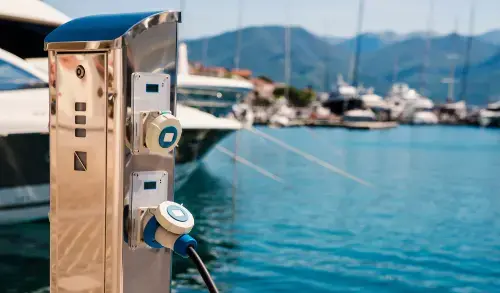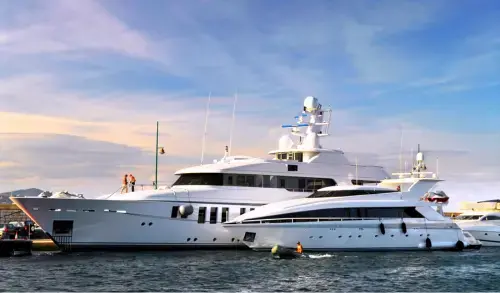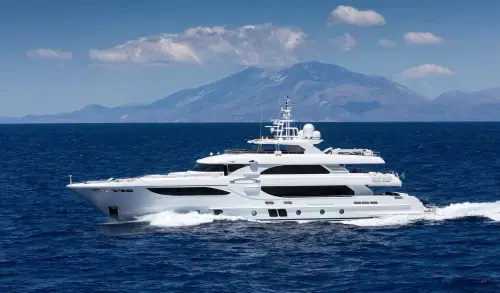The Advantages of a Dual Marine Shore Power Cord Input Converter
Modern yachts are more power-hungry than ever before. High-capacity HVAC systems, advanced navigation electronics, stabilized platforms, and hotel...
3 min read
Atlas Marine Systems : Sep 16, 2025 10:07:00 AM

Modern vessels rely heavily on consistent, reliable electrical power, especially when docked. Rather than running generators at the marina, most yachts connect to local electrical infrastructure, known as marine shore power, to run onboard systems.
But as boats cruise from port to port, they often encounter an unexpected challenge: the shore power at marinas is not always consistent. This mismatch between dockside supply and onboard demand can lead to inefficiencies, equipment issues, or complete incompatibility.
In this article, we’ll take a closer look at the types of shore power commonly available in U.S. marinas, the growing presence and limitations of 208V 3-phase, and what boat owners and engineers can do to ensure safe, seamless power connections wherever they dock.
Marine shore power in the U.S. is far from standardized. The most common configurations found in marinas vary based on boat size, marina infrastructure, and regional utility setups.
For smaller boats, typically under 35 feet, 30A 120V single-phase service is the standard. Mid-sized to larger yachts commonly plug into 50A or 100A of 120/240V split-phase power, which supports heavier onboard loads like air conditioning and galley appliances.
However, as you move into larger slips, 208V 3-phase power becomes more prevalent. This setup, while practical from a utility distribution standpoint, often creates issues for watercraft.
Some docks for very large yachts provide 480V 3-phase service, further highlighting how inconsistent shore power setups can be across marinas. For captains and engineers, that means one thing: you can’t assume what’s available dockside will match your vessel’s needs. Having a plan to manage those differences is essential.
Many larger slips in the U.S. offer 208V 3-phase shore power. Although common, it does not always align with the electrical requirements of many vessels.
Delivered through a Wye-configured transformer
Supplies 208 volts between phases
Supplies 120 volts from each phase to neutral
Popular in commercial infrastructure because it is efficient and cost-effective
The challenge with marine shore power is not just availability. It is alignment.
Vessels have a wide range of electrical configurations. Many U.S.-built boats use 240V single-phase, while international or European ships are often equipped with 400V 3-phase at 50Hz. These systems are not designed to work with 208V 3-phase shore power, which is becoming more common in larger marinas.
Undervoltage: Equipment designed for 240V may not perform correctly on 208V, which can cause poor performance or damage.
Phase mismatch: Yachts that use delta or international configurations may not align with Wye-distributed 208V power.
Frequency mismatch: Boats that require 50Hz power cannot run certain systems safely on 60Hz without conversion.
Safety risks: Improper connections can lead to tripped breakers, overheating, or equipment failure.
These issues often surface when it is too late, such as after a failed connection or equipment malfunction. That’s why identifying potential mismatches in advance and having a reliable solution in place can help avoid costly setbacks.
Shore power mismatches are common, but they are also manageable with the right equipment onboard. The best way to ensure safe and consistent power, regardless of marina supply, is by using a shore power converter system.
Accept a wide range of input voltages and frequencies (including 208V 3-phase and 60Hz)
Convert power to match your vessel’s specific requirements, such as 240V single-phase or 400V 3-phase at 50Hz
Provide clean, stable power for all onboard systems, including HVAC, refrigeration, navigation, and communications
Protect sensitive equipment from voltage drops, surges, or imbalances
Avoids the risk of electrical damage or interrupted service
Expands the number of marinas you can confidently plug into
Reduces reliance on generators, cutting fuel use and noise
Keeps critical systems running smoothly during dock stays
Shore power conversion systems are a practical solution for vessels that operate in diverse marina environments. By managing voltage and frequency inconsistencies, these systems provide a stable power source regardless of what is available dockside.
Marine shore power can be unpredictable. While many marinas offer basic 30A or 50A service, others supply 208V 3-phase power that may not align with your vessel’s electrical system. These mismatches can cause more than just inconvenience. They can lead to serious performance issues or equipment damage if not handled properly.
The key is preparation. Understanding what your craft needs, what different marinas offer, and how to safely bridge that gap is essential for reliable operation at the dock. A shore power conversion system is often the best long-term solution for vessels that travel frequently or operate across multiple regions.
If you are dealing with power mismatches or planning electrical upgrades, it's important to evaluate your options. Contact Atlas Marine Systems, and we can help you find a shore power solution that fits your vessel and travel needs.

Modern yachts are more power-hungry than ever before. High-capacity HVAC systems, advanced navigation electronics, stabilized platforms, and hotel...

Marina shore power is often unpredictable. Voltage fluctuations, frequency mismatches, and electrical surges can compromise critical onboard...

Some shore power frequency converters deliver years of reliable performance with minimal issues, while others fail prematurely, often when you can...